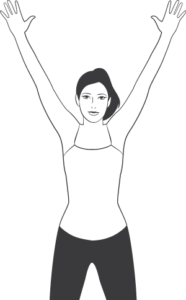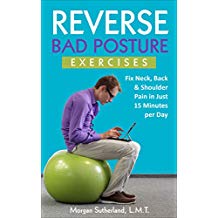Sedentary lifestyles inevitably result in thousands of hours spent hunched over, with your body resembling a human question mark—head jutting forward, shoulders rounding, and your back curved. Over time, this Quasimodo-like posture has given rise to a smartphone-related cervical spine injury commonly referred to as “Text Neck.” In this article, I’ll walk you through how to prevent Text Neck Symptoms in 5 simple steps.
Text Neck Symptoms and Forward Head Posture
Text Neck, also known as Tech Neck, is a repetitive stress injury that affects your neck, upper back, forearms, wrists, and hands, caused by poor posture and prolonged smartphone use. Sustaining a forward head posture overstretches the neck muscles, leading to soreness, inflammation, and a stiff neck. One of the most common text neck symptoms is a persistent crick in the neck or tightness in the shoulders.
- Over-stressing your neck muscles from texting
- Awkward sleep positions
- Harsh twists or turns during exercise
- Spending hours hunched over at your desk in poor posture
If left unchecked, text neck symptoms can lead to pinched nerves, herniated discs, and even reduce the natural curve of the neck.
Next time you slump forward to check your phone, think about this:

The average human head weighs around 10 pounds—about the same weight as a bowling ball. Now, imagine carrying that bowling ball directly over your spine all day. It’s not too bad, right?
But here’s the catch: For every inch your head moves forward, it adds an additional 10 pounds of pressure on your neck and spine. So, if your head is just three inches forward—something that happens easily when looking down at a phone—your neck is under a whopping 42 pounds of strain.
That’s like having a small child hanging off your neck all day! It’s no surprise that your neck feels sore and tight after hours of scrolling. This constant strain can lead to long-term issues like tension headaches, stiff muscles, and even permanent changes in your posture.
Text Neck and Rounded Shoulders
If you suffer from Text Neck, it’s very likely you also have rounded shoulders. When your shoulders round forward, your chest muscles tighten, and your upper back muscles overstretch. This poor alignment can compress the brachial plexus (a network of nerves that runs from your neck through your armpits), leading to issues like numbness in your hands, thoracic outlet syndrome, or even carpal tunnel-like symptoms.
5 Steps to Fix Forward Head Posture and Prevent Text Neck Symptoms
Let’s dive into the 5 actionable steps you can take to fix your posture and avoid text neck symptoms.
Step #1: Bring Your Phone to Eye Level
Instead of constantly looking down at your phone, bring it up to eye level. This simple adjustment helps to reduce the strain caused by forward head posture, which places unnecessary pressure on your neck and upper back muscles.
Over time, that strain can lead to stiffness, soreness, and even long-term postural issues. By raising your phone, you maintain a more neutral spine position, preventing that “hunched” look.
Remember, it’s all about the angles—small changes make a big difference. And while you’re at it, stop using your shoulder to hold your phone against your ear, as this can cause further tension and misalignment.
Step #2: Use a Hands-Free Headset
 Whenever possible, use a Bluetooth headset or speakerphone to avoid holding your phone for extended periods. Holding your phone against your ear not only strains your neck but also puts unnecessary pressure on your wrists and forearms.
Whenever possible, use a Bluetooth headset or speakerphone to avoid holding your phone for extended periods. Holding your phone against your ear not only strains your neck but also puts unnecessary pressure on your wrists and forearms.
A hands-free device keeps your neck in a neutral position, reducing tension and giving your arms a break from the awkward positions that can lead to repetitive stress injuries. By switching to a headset, you’ll prevent common issues like neck stiffness and reduce the risk of developing text neck symptoms over time.
Step #3: Chin Tucks and Wall Angels
 Chin Tuck Exercise: This simple move helps reverse forward head posture by strengthening the muscles in your neck.
Chin Tuck Exercise: This simple move helps reverse forward head posture by strengthening the muscles in your neck.
Whether sitting or standing, roll your shoulders back and down. Then, place two fingers on your chin and gently tuck it while moving your head back.
Hold for 3-5 seconds and repeat 10 times. The more double chin you create, the better!
Tip: Try this while sitting in your car, pressing the back of your head into the headrest.
Wall Angels: Stand with your feet about four inches away from the wall, knees slightly bent. Rest your glutes, spine, and head against the wall. Bring your shoulder blades together to form a “W” with your arms. Hold for 3 seconds, then raise your arms into a “Y” without shrugging your shoulders. Repeat 10 times for 2-3 sets.
Step #4: Book a Massage
If the tension in your neck and upper back is persistent, a professional massage can work wonders. Ask your massage therapist to focus on the kinks in your neck, back, and even your overused forearms and wrists. Don’t underestimate the power of a deep-tissue massage!
Step #5: Practice Reverse Bad Posture Exercises
To truly correct your posture and prevent future issues, pick up a copy of my book, Reverse Bad Posture Exercises. The 21 exercises are designed to fix forward head posture, rounded shoulders, and that hunched-back look in just 15 minutes a day.
With consistent practice, you’ll not only improve your posture but also prevent neck, shoulder, and back pain episodes from becoming a recurring issue. These easy-to-follow exercises fit seamlessly into any routine, making it simple to stay on track. Plus, you’ll notice not just better posture, but increased confidence as you stand taller and feel more aligned.
Final Thoughts
By following these 5 simple steps, you’ll fix forward head posture and prevent text neck symptoms. Don’t let bad posture wreak havoc on your body—start making small changes today, and stay plugged in without the pain!
Recommended Reading
Avoid These 4 Common Smartphone Injuries
11 Exercises That Will Help You Grow 3 Inches Taller



